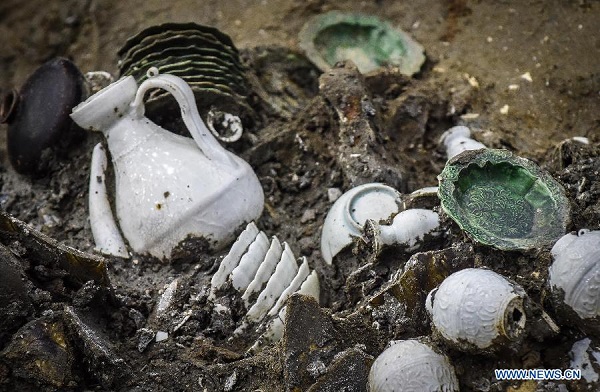Underwater archeology cooperation hub set up

Photo taken on Jan 28, 2015 shows artifacts discovered on the Nanhai No 1 ship at the Marine Silk Road Museum in Yangjiang, South China's Guangdong province. [Photo/Xinhua]
An international cooperation center for underwater archaeology has been established in Guangzhou, capital of Guangdong province, to deepen academic exchanges on underwater archaeology in the Guangdong-Hong Kong-Macao Greater Bay Area and expand international cooperation in Southeast Asia.
The center, located at a scientific research base in Nansha of Guangzhou, will collaborate with local marine geological survey authorities and other departments to explore deep-sea archaeology, according to the Guangzhou Marine Geological Survey.
It will assist in conducting underwater archaeological surveys in the province in coordination with a nationwide cultural relics survey, and soon establish a geographic information management system for underwater archaeological cultural heritage in the GBA, the local marine geological survey said.
Specifically, it will strengthen collaboration with the archaeological research center of the National Cultural Heritage Administration and relevant scientific research institutions, colleges and universities, and cultural organizations in the GBA to promote innovative underwater archaeological excavation, research and development of key archaeological scientific technologies and the improvement of archaeological technical equipment.
It will also strengthen international cooperation and exchanges in the protection and restoration of underwater cultural relics, the transformation of archaeological achievements, and talent cultivation.
The establishment of the center came after a series of policies issued by the Guangdong government to strengthen cultural heritage protection and archaeological work over the last few years, including a five-year plan for cultural heritage protection and technological innovation.
Guangdong is a key area for underwater archaeology, with several major underwater archaeology projects already being carried out in the province.
After the excavation of the Nanhai No 1 and Nan'ao No 1 shipwrecks, which were ancient cargo ships that sank in the South China Sea, Guangdong has taken the lead across the country with the establishment of two provincial-level underwater cultural heritage protection zones.
In a recent development, an overall protection project for Nanhai No 1, a sunken ship from the Song Dynasty (960-1279), has been approved after years of archaeological excavation on the ancient wooden ship, which sank while transporting Chinese porcelain.
It was salvaged in 2007 and is currently preserved at the Maritime Silk Road Museum on Hailing Island in Yangjiang, a coastal city in western Guangdong.
Porcelain products, gold, silver, copper and iron relics, and copper coins are just some of the 180,000 treasures found within Nanhai No 1. Bamboo and wooden lacquers and the preserved remains of plants and animals have also been recovered.
According to the overall protection project, archaeological excavation on Nanhai No 1 will be completed by the end of this year, and efforts will be shifted to a new stage of comprehensive protection, research, utilization, exhibition and academic exchanges.
Archaeological investigation of Nan'ao No 1, a sunken merchant vessel of the Ming Dynasty (1368-1644), will be completed by the end of this year, according to the cultural heritage authorities of Guangdong.
The vessel was found in 2007 in the South China Sea near Nan'ao Island, in eastern Guangdong, after a local fisherman netted porcelain ware.
Additionally, there has been a breakthrough in the construction of an underwater cultural heritage protection center, and it is expected to be officially put into operation next year.
All rights reserved. Presented by China Daily









